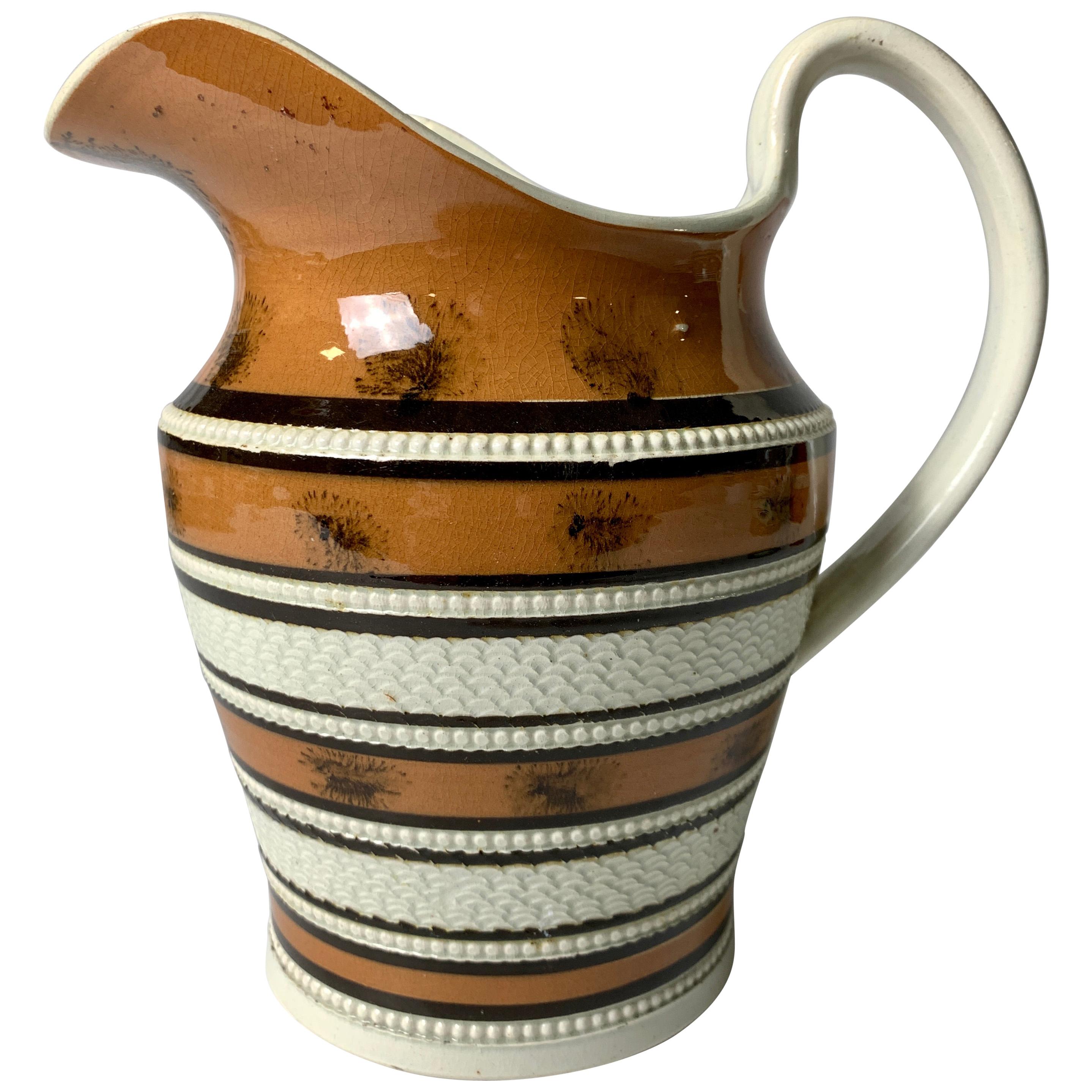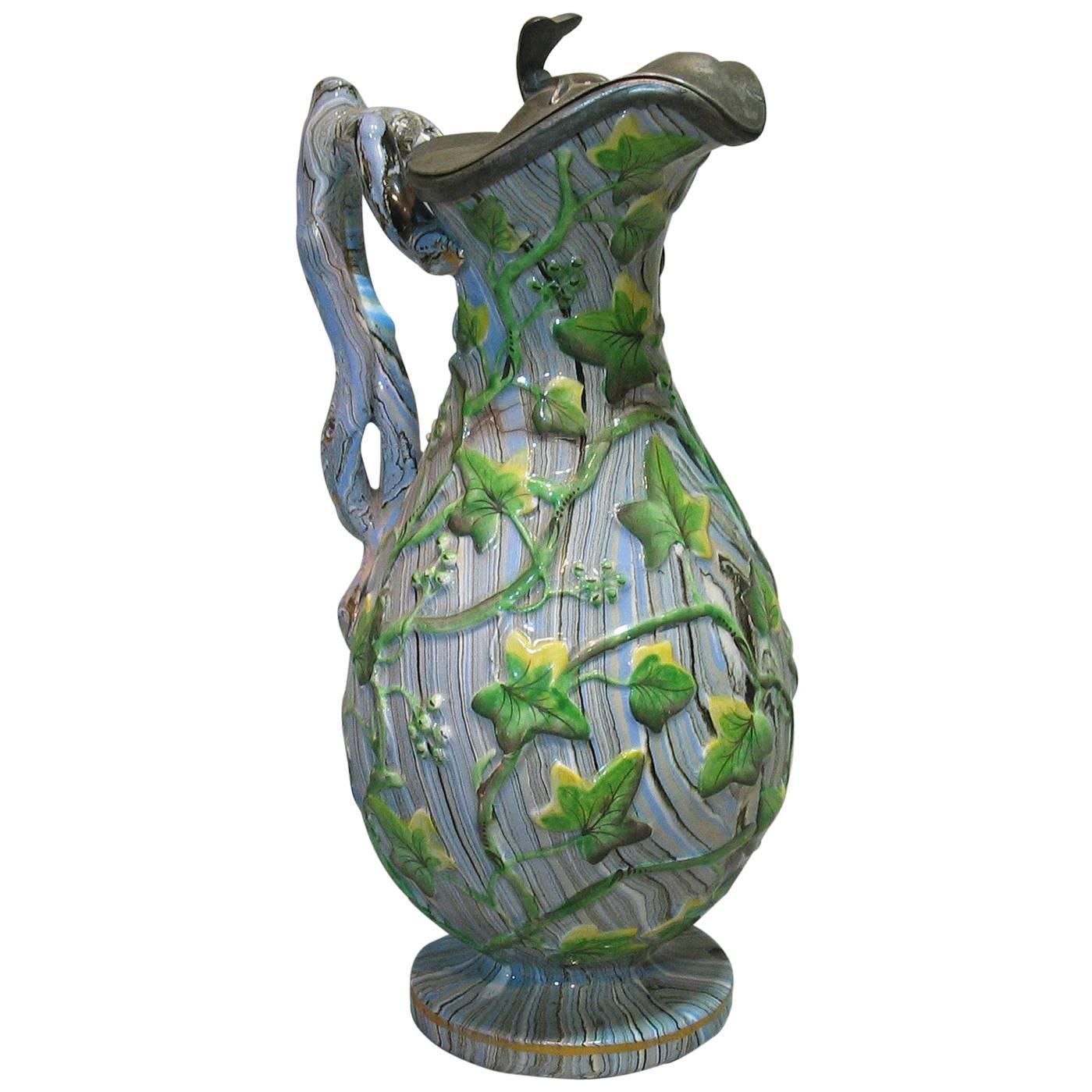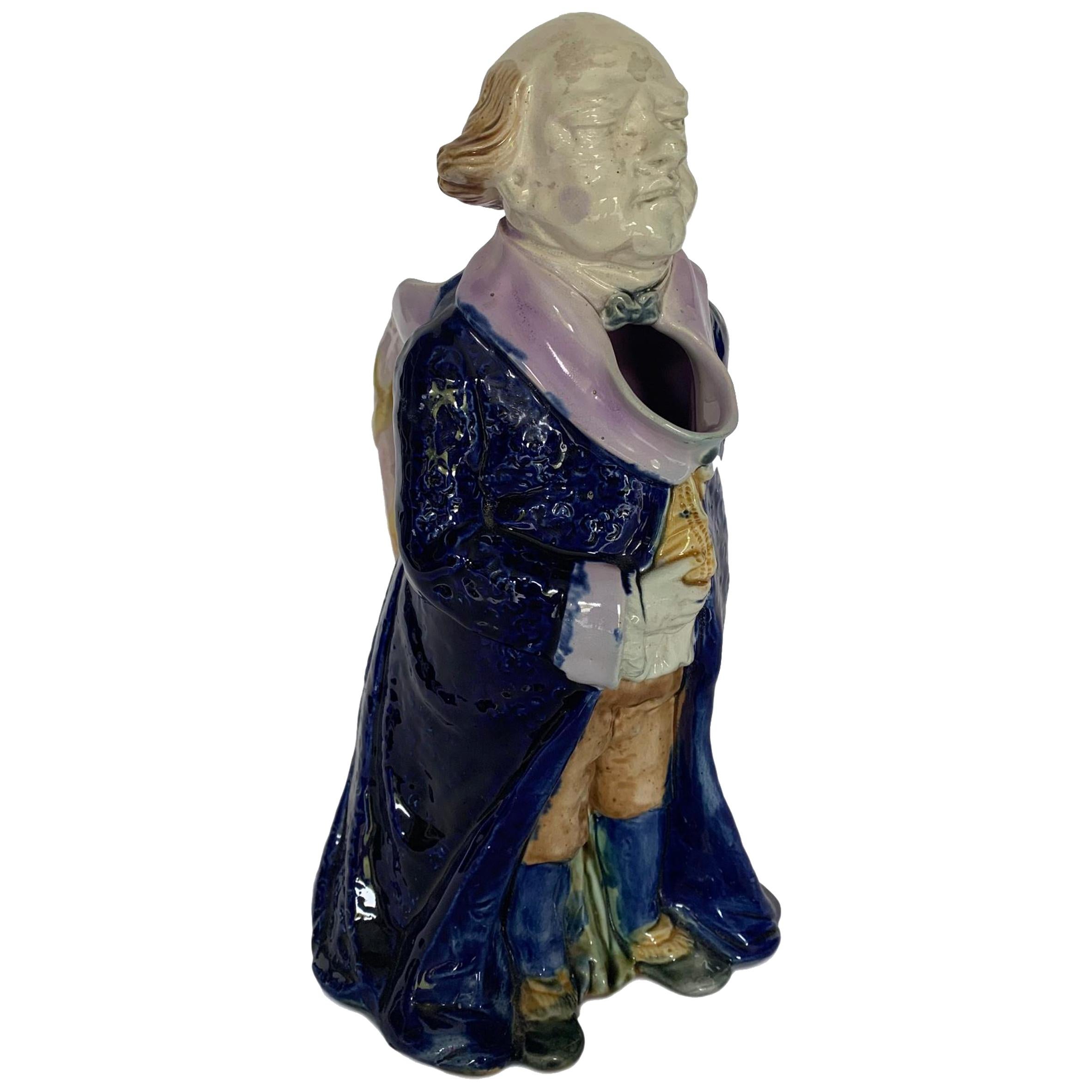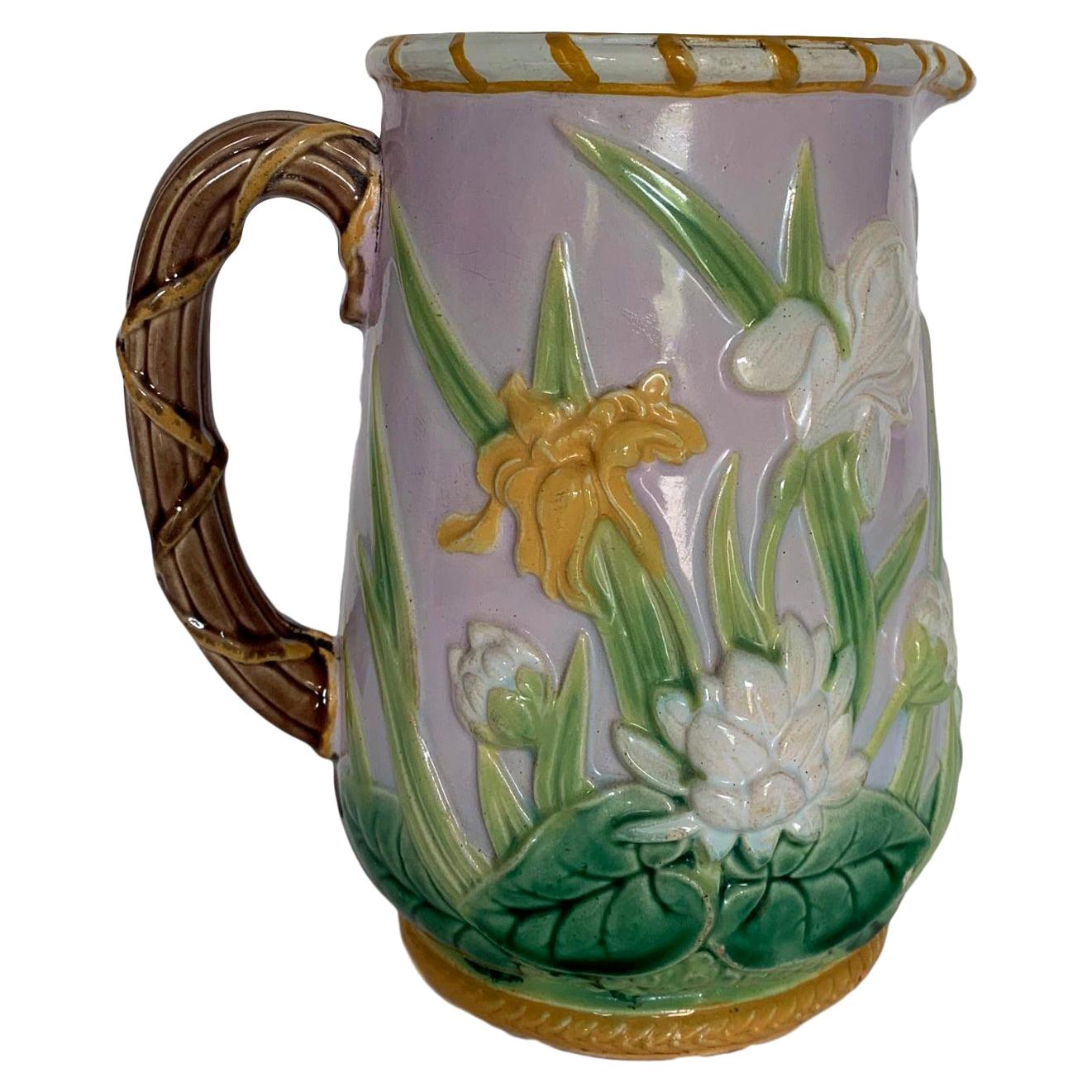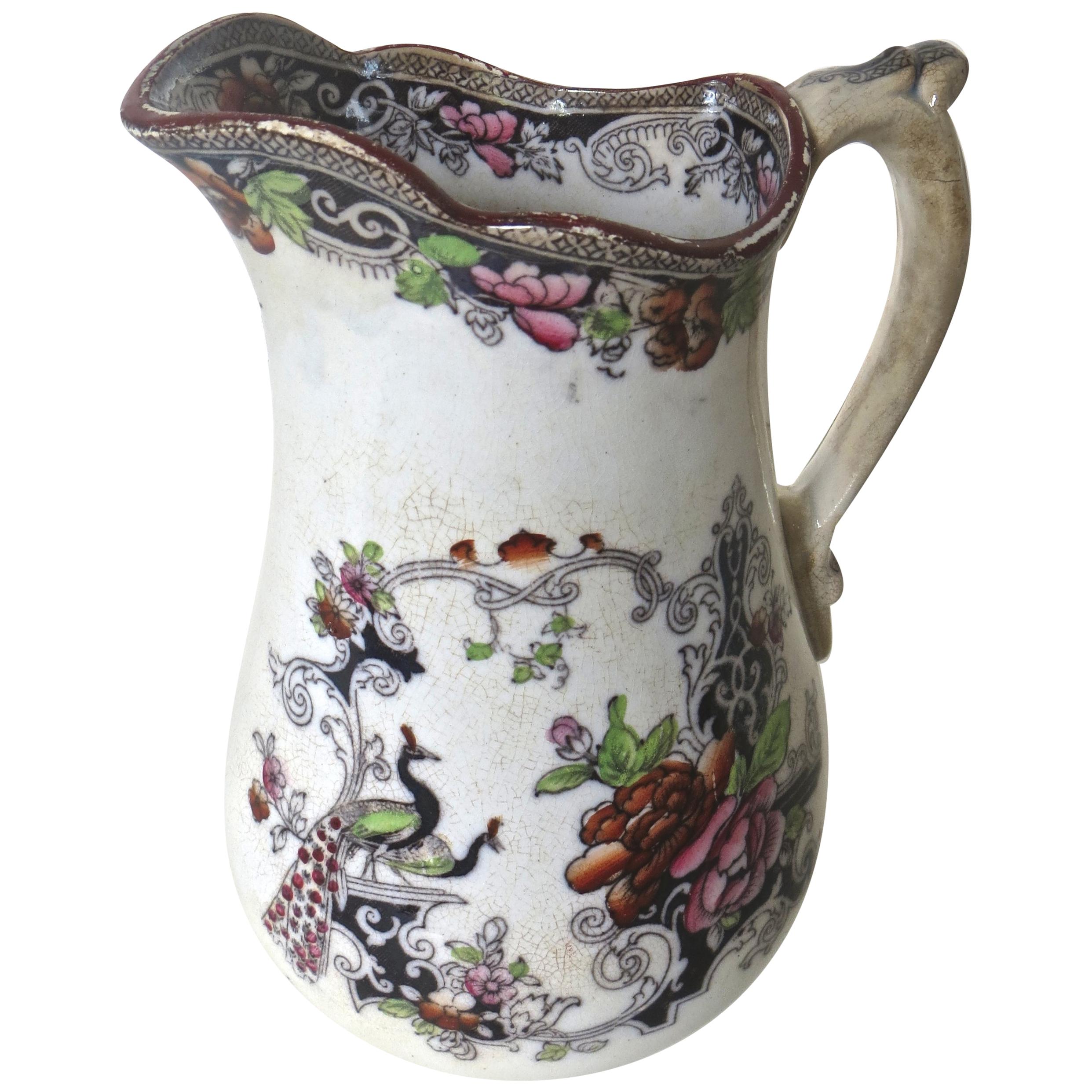Items Similar to Staffordshire Porcelain Pitcher England Circa 1830
Want more images or videos?
Request additional images or videos from the seller
1 of 7
Staffordshire Porcelain Pitcher England Circa 1830
About the Item
This simple, charming Staffordshire porcelain pitcher is perfect for flowers.
Made in England circa 1830, the pitcher has a beautiful hand painted bouquet on the front.
We see colors of pink, light blue, yellow, purple, orange, and two tones of green on the leaves.
Three horizontal gilt bands define the base, neck, and top of the pitcher.
The handle has an embossed decoration of leaves on the vine.
Dimensions: 6.75" tall x 6.5" from the end of spout to end of handle x 4.75" diameter at the widest point and 3" diameter across the base
Condition: Very good, with slight wear to the painted enamels (see close-up images). The porcelain and gilding are perfect.
Price: $285
Background of Staffordshire Pottery: By the late 18th century, North Staffordshire was Britain's largest producer of ceramics, despite significant centers elsewhere. Large export markets took Staffordshire pottery around the world, especially in the 19th century.
- Dimensions:Height: 6.75 in (17.15 cm)Diameter: 4.75 in (12.07 cm)
- Style:Country (Of the Period)
- Materials and Techniques:
- Place of Origin:
- Period:
- Date of Manufacture:Circa 1830
- Condition:Wear consistent with age and use.
- Seller Location:Katonah, NY
- Reference Number:
About the Seller
5.0
Recognized Seller
These prestigious sellers are industry leaders and represent the highest echelon for item quality and design.
Platinum Seller
These expertly vetted sellers are 1stDibs' most experienced sellers and are rated highest by our customers.
Established in 1962
1stDibs seller since 2009
422 sales on 1stDibs
Typical response time: 1 hour
- ShippingRetrieving quote...Ships From: Katonah, NY
- Return PolicyA return for this item may be initiated within 30 days of delivery.
More From This SellerView All
- Mochaware Pitcher Decorated with ""Trees" and Seaweed" England, circa 1810Located in Katonah, NYMade in England circa 1810, this mochaware pitcher is decorated with "Trees" and "Seaweed" It is molded in an elegant shape with an extra-wide mouth, probably made this way so that pieces of fruit in a punch could pour out. The pitcher has bands of orange-brown slip decorated with both "Trees" and "Seaweed". These dendritic designs are part of what make mochaware is unique. The design is formed by using small amounts of an acidic dark brown liquid and carefully dropping this liquid onto the alkaline orange slip...Category
Antique Early 19th Century English Country Pitchers
MaterialsEarthenware
- Large Odd Fellows Pitcher England, Circa 1850Located in Katonah, NYThis massive and rare pitcher is fully decorated with the imagery and symbols of the Odd Fellows (see images). Odd Fellows promote philanthropy, the ethic of reciprocity, and charity. At the front of the pitcher, we see a panel with the words, "We are odd Fellows When we act and Do the thing which is Right." Around this panel are the words "How grand in Age How fair in Youth is Holly Friendship, Love and Truth." Above the panel is an open palm with a heart symbolic of charity given from the heart. On both sides of the pitcher is the Odd FFellows'smotto, "Amicitia Amor et Veritas,"; which translates to Friendship, Love, and Truth. The motto is seen together with an image of Lady Justice and an angel holding a budding branch. Lady Justice personifies morality in judicial systems. The budding branch symbolizes the idea that truth can "draw freshness and verdure" from the "most barren facts and common things in life" and give them life and interest. Above all of this is a shining sun. As the sun shines on us all, it symbolizes impartiality in the benevolence of the Odd Fellows. Dimensions: 9.75" tall x 8.25" diameter Condition: Very Good, with an invisible restoration only to the underside of the vase and some scratching, particularly to the lustered leaves, flowers, and the lustered top edge. Price: $1640 Odd Fellows is an international fraternity consisting of lodges first documented in 1730 in London. The first known lodge was Loyal Aristarcus Lodge No. 9, suggesting earlier ones in the 18th century. Notwithstanding, convivial meetings were held "in much revelry and, often as not, the calling of the Watch to restore order. Names of several British pubs...Category
Antique Early 19th Century English Early Victorian Pitchers
MaterialsEarthenware
- Mochaware Pitcher Decorated with Chocolate Brown Slip England circa 1815Located in Katonah, NYMade in England circa 1815 this mochaware pitcher is decorated with bands of lovely milk chocolate-colored slip. The color works beautifully with the unpainted creamware body of the handle and interior of the pitcher. Just below the top edge, we see a band of black and white rouletting, and above the bottom edge is a similar black and white rouletted band. Dimensions: 5.75" tall x 4" at the widest point Condition: Very Good: two short hairlines of approximately half an inch are seen on either side of the top edge. There is a hairline on the underside which does not go through. Price: $1360 Background of Mochaware: Mochaware pottery...Category
Antique Early 19th Century English Ceramics
MaterialsCreamware
- Antique French Porcelain Pitcher Hand Painted Empire Period, Circa 1815Located in Katonah, NYMade in the Napoleonic period, this exquisite French porcelain pitcher was hand-painted in the Empire style. It boasts classical and rococ...Category
Antique Early 19th Century French Empire Pitchers
MaterialsPorcelain
- Pair Antique English Porcelain Dishes Hand Painted Roses England Circa 1830By StaffordshireLocated in Katonah, NYA pair of Antique English porcelain dishes hand-painted with beautiful pink peonies and other flowers were made in England circa 1830....Category
Antique Early 19th Century English Early Victorian Decorative Dishes and...
MaterialsPorcelain
- Set of Five Antique Porcelain Dishes Hand-Painted, England, Circa 1830By Coalport PorcelainLocated in Katonah, NYThis set of five Coalport Porcelain dinner dishes was made in England circa 1830. In the center of each one is a bouquet of exquisite hand-painted flowers. The close-up images show...Category
Antique 1830s English Early Victorian Dinner Plates
MaterialsPorcelain
You May Also Like
- Rare Staffordshire Agateware Pitcher with Pewter Lid, circa 1840By James Dixon & SonsLocated in Ottawa, OntarioRare Staffordshire agateware pitcher with pewter lid, circa 1840. Baluster shaped body molded overall, with vinery in greens and yellows on a b...Category
Antique 1840s English Art Nouveau Pitchers
MaterialsPewter
- Majolica Mr. Pickwick Large Pitcher, England, circa 1885By Joseph HoldcroftLocated in Banner Elk, NCMajolica Mr. Pickwick large pitcher, England, circa 1885. Attributed to Joseph Holdcroft. Gorgeous color, in excellent condition. For over 28 years we ha...Category
Antique 1880s English Victorian Pitchers
MaterialsCeramic
- George Jones Majolica Iris Pitcher, England, circa 1875By George JonesLocated in Banner Elk, NCGeorge Jones Majolica Iris Pitcher, England, Victorian, ca. 1875 For 30 years we have been among the world’s preeminent specialists in fine antique majolica.Category
Antique 1870s British Victorian Pitchers
MaterialsCeramic
- Mid-Size Ironstone Pitcher by “W & J Butterfield” England, circa 1855Located in Incline Village, NVNice example of an ironstone pitcher, hand painted from copper plate transfers in the Chinese Manduran pattern depicting peacocks and abundant floral decoration in a Famille Rose sty...Category
Antique 1850s English Victorian Pitchers
MaterialsIronstone
- French Pottery Pitcher, Circa 1890Located in Austin, TXSmall 19th century blue ceramic pitcher or creamer from Savoie, France. No maker's mark. Measures: Height / 2.5 inches.Category
Antique 1890s French Country Pitchers
MaterialsPottery
- Antique English Staffordshire Transferware Serving Creamer Jug PitcherLocated in Dayton, OH"Antique 20th century Staffordshire transferware porcelain jug or pitcher featuring an English landscape in black, originally designed by James Cutts for W. Adams & Sons, and a yellow border around the upper edge. “James Cutts was born in 1808 in Pinxton, Derbyshire, he was the 9th of 10 children and the youngest of five boys. His father, John Cutts, was a moderately gifted china painter, trained at the Derby porcelain works, who moved to become manager of the Pinxton porcelain...Category
Early 20th Century Late Victorian Porcelain
MaterialsPorcelain
Recently Viewed
View AllMore Ways To Browse
Staffordshire Blue Pitcher
Danish Silver Tankard
Vintage Brass Water Pitcher
Georgian Water Jugs Glass
Georgian Water Jugs
Vintage Beer Pitchers
Antique Crystal Water Pitcher
Coffee Pitcher English Silver
Hunting Jug
Hydra Jug
Masons Hydra
Pitcher With Horn Handle
Retro Coffee Carafe
Swan Pitcher
Antique Clear Glass Water Pitcher
Arts And Crafts Copper Pitcher
Ceramic Fish Jug
Mcm Pitcher
